
How we built over 22,000 links. Part 2: Seasonality
Actually, we’ve now built 23,195 links (and counting) for our clients. That’s a hell of a lot of links.
We’ve worked on over 180 campaigns across a huge number of industry sectors – including travel, finance, automotive and fashion – with a clear mission in mind: to improve the backlink portfolio of our clients with high-quality, natural links that’ll improve organic search results for key terms.
Our approach is built on providing a scalable alternative to digital PR. And one that gets results. Campaigns are structured to expand a client’s portfolio of unique, high-quality referring domains – including protected domains such as .gov, .nhs, .edu and .ac.uk
Over the years we’ve learned a lot. So, we thought it past time to step out of the shadows and share the processes that help our clients achieve brilliant results.
This is the second part of a series of articles we’ll publish to break down our link building approach – this time turning our attention to the all-important topic of seasonality – and how to plan your link strategy and outreach efforts with a data-backed, evidence approach.

How important is seasonality?
In our first post, we covered the crucial element of content. For any links campaign to be successful, it needs to be spearheaded by exceptional content that’ll turn heads and appeal to a wide range of audiences. The ultimate goal of any link campaign is to persuade and encourage webmasters, editors and bloggers to recommend you to their site’s audience. So, it’s got to be good.
Covering linkability, successful themes, and traps to avoid, we shared our years of experience that delivered an opportunity to take what we had learned and apply it to your own future campaigns.
But even with the right piece of content behind you, timing is everything.
“Hang on…” I hear you say. “What if we’re creating evergreen content that can be used all year round, rather than being tied to a particular season, event or time of the year?”
Well, even with this approach, seasonality will impact your success. We’ve discovered over the last 10 years there are certain times when any content (no matter the topic) will be more successful.
Without further ado, here’s all the data you need to inform your link building campaigns – along with our tips to help you maximise opportunities and achieve your goals.
Monthly trends (2015-2023)
Let’s start with the most important question. Is there a time in the year that a link campaign will be most successful?
Simply put, yes.
As data from one particular year might not be enough to justify a strategy, we decided to incorporate over half a decade’s worth of results. We’re able to use this internally to forward plan, double down on seasonally higher performing times of the year and launch campaigns at the right time.
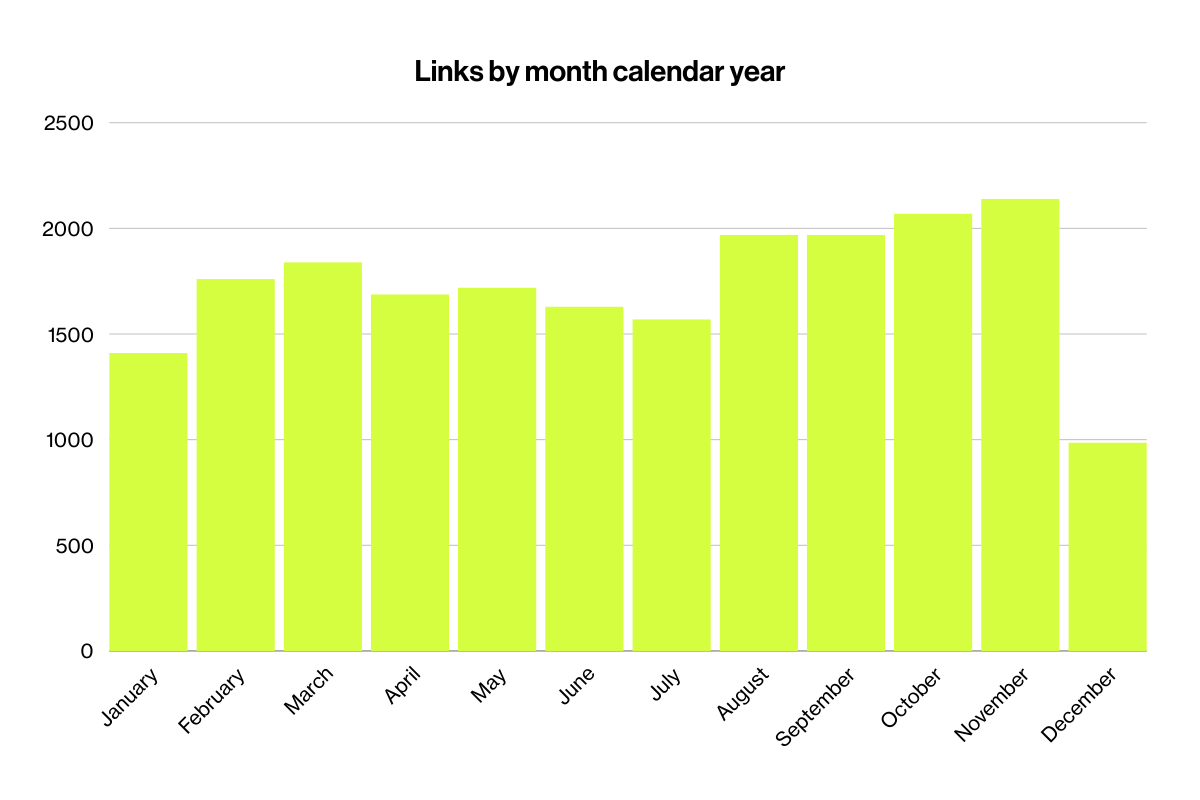
This is a pattern we see year in, and year out.
Key insights:
December, January – The holiday season heavily influences link building. From mid December through to the first week of the new year, many people are out of the office or wrapping things up before a company-wide shutdown… which significantly impacts link acquisition during these times. The drop-off in December is monumental – so avoid launching a new campaign at this time.
June, July, and mid August – The summer months also impact our link building efforts – as many people are taking time out of work to go on holiday or look after children (or cover colleagues doing either of the above).
September, October, and November – These months tend to see the highest volume of link placements throughout the year. There are no major UK or US holidays to plan for – leading to little disruption and, most importantly for us, a period of uninterrupted business operations.
November – Historically, this is the strongest month for link placements. Our theory is that November benefits from the consistency of the previous 90 days of “business as usual,” culminating in the highest number of successful placements in the year.
Here’s that data in a different format, representing a visual trend from lowest to highest performing months.
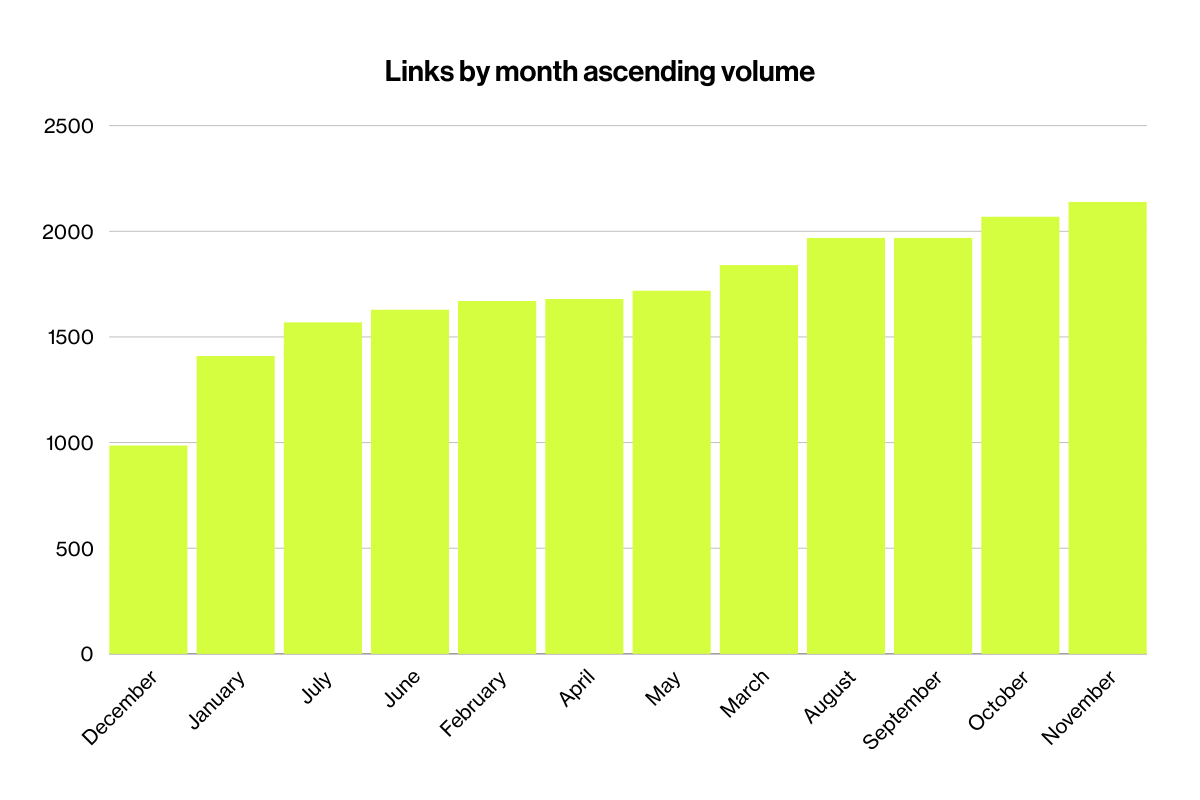
However, this data doesn’t quite tell the whole story. Effective link building will take place over a long period of time – it’s not something you want to turn on or off depending on the month of the year.
Understanding quarterly trends is also important – putting this into context, the December shift has a significant impact on Q4. Despite strong Octobers and Novembers, it’s actually the calendar year’s Q3 (as a collective) that produces better results.
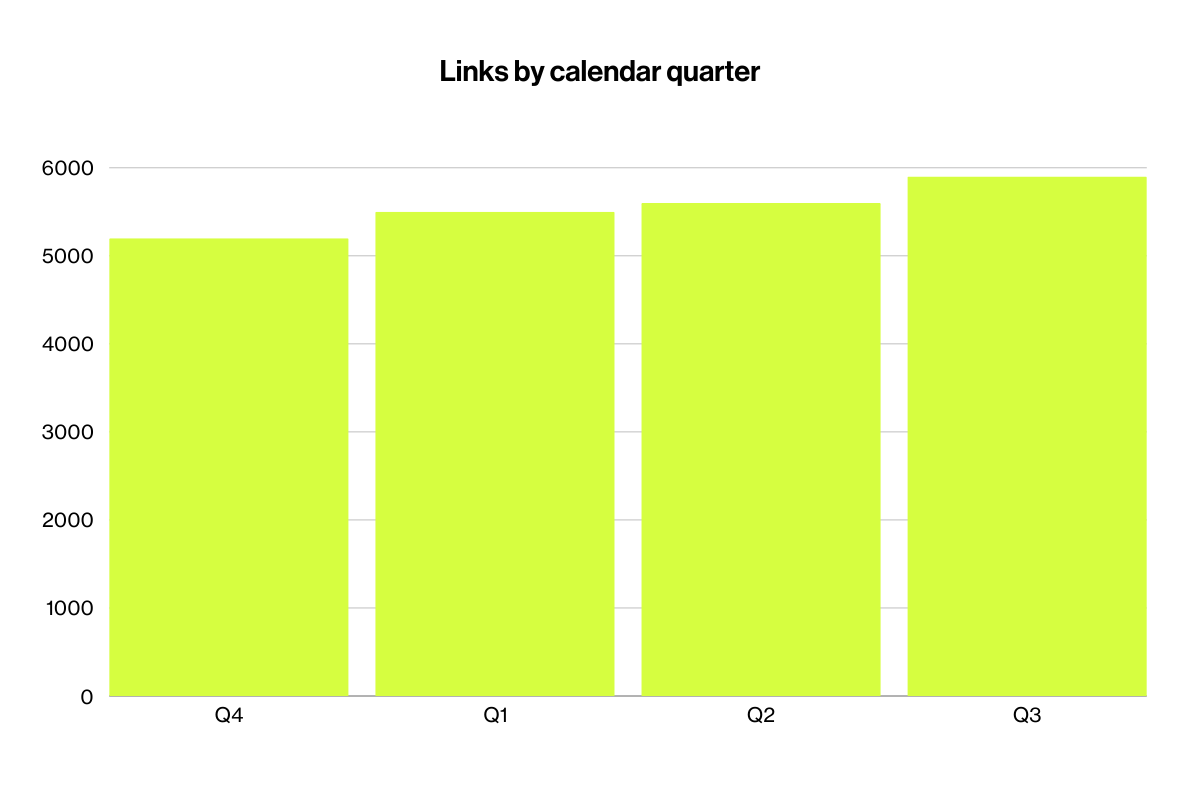
As a final point, an interesting observation when looking at seasonal trends across any 12-month period, during a time of national crisis (and when things are certainly not ‘business as usual’), we don’t tend to see a shift away from the above patterns.
Here is data collected during the height of the COVID-19 pandemic, with accompanying information directly related to the UK at the time. As you can see, by and large, the same pattern exists, with a decline in links during the summer months, and an uplift heading into autumn. December, notably, was the lowest-performing month across that time period.
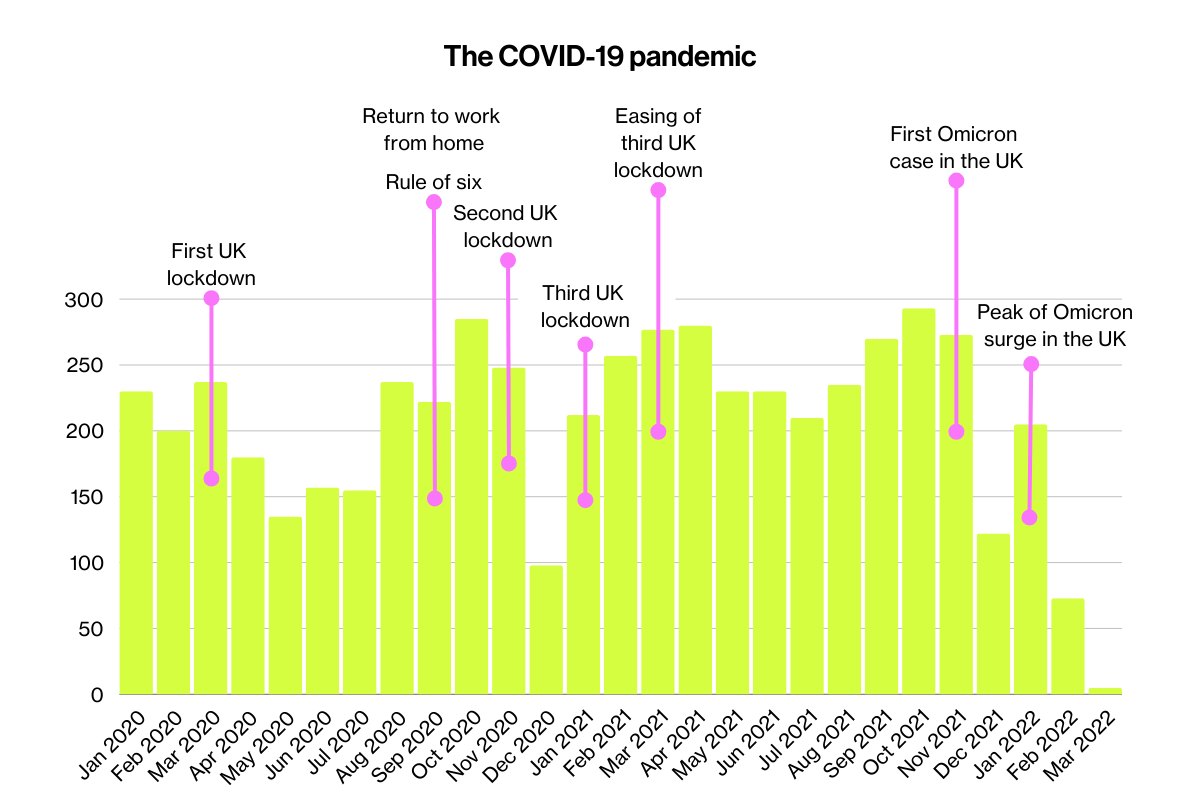
Naturally, we adjusted our content to focus on what people wanted to know more about, with a shift in theme to:
Mental wellbeing, mental health
Screen time, screen/smartphone usage
Remote work, work from home (WFH)
Travel safety awareness
Outdoor tips/advice, responsible tourism
Study resources, advice for students and parents
COVID-19 resources, lockdown advice
Tracking trends by link type (2015-2023)
Whilst the previous dataset gives us an indication of seasonal fluctuation, there isn’t necessarily a blanket rule that applies to all link types. This will be covered in more detail in a later post, but we typically build four different types of links, and are trialling a fifth:
Resource page links:
Identifying websites and pages that link to external data and guides, as a way of providing further information.
Guest posts:
Locating websites offering free guest post placements, and writing an article in-house referencing our client, as well as a range of other useful external sources.
In content:
Targeting content that already exists on the web, with a thematic relevance to our client or what we want to cover. As the content already exists, our aim is to place a link into this existing piece.
Unlinked brand mentions:
Particularly beneficial for brands with a large internet footprint – the client’s mention already exists, so we’re able to reach out to the webmaster and ask that this be converted into a link.
Link intersect:
A new product we’ve tested recently. The idea is to piggyback on successful competitor content (particularly tools and calculators). We identify high authority websites linking to a close competitor, who aren’t linking to the client.
For the purposes of the data below:
We’re using the broader ‘editorial links’ term to collectively refer to links we’ve built that are located within articles (in content and guest posts).
Resource page and editorial links together form the bulk of our link placements (92%) – therefore we haven’t captured options 4 and 5 (unlinked brand mentions and link intersect).
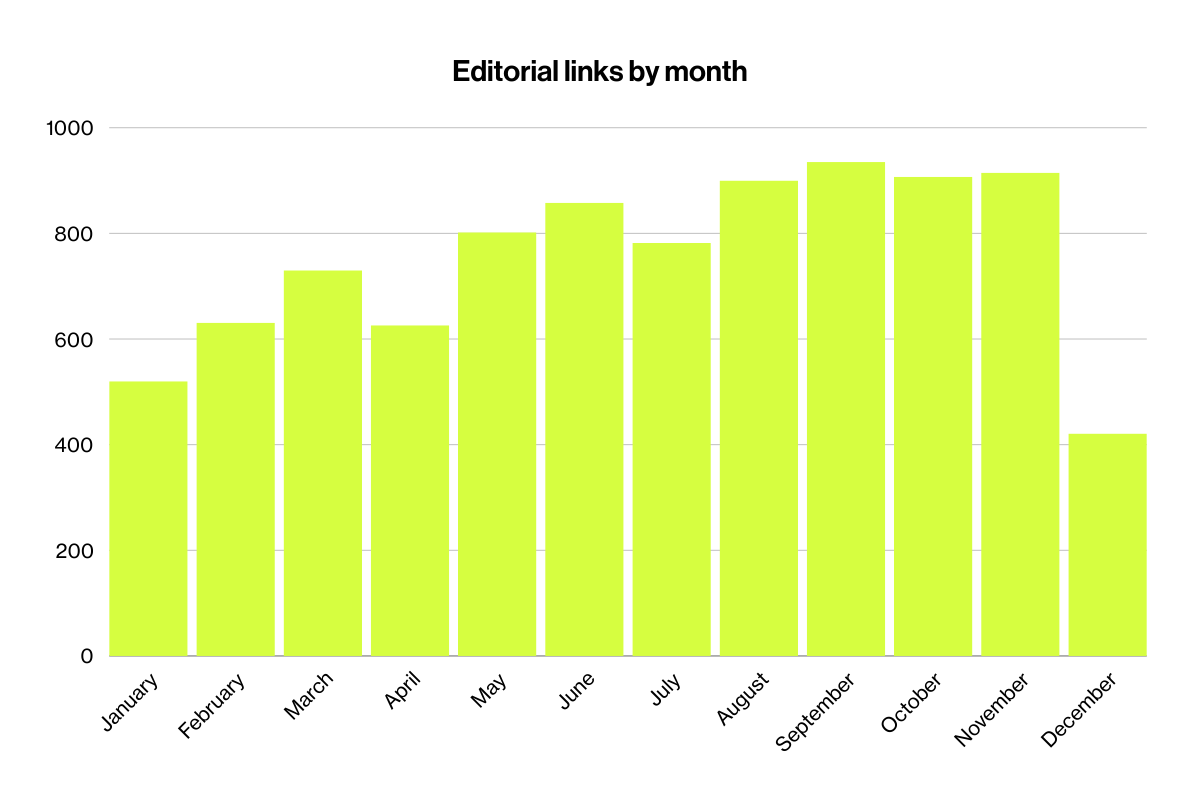
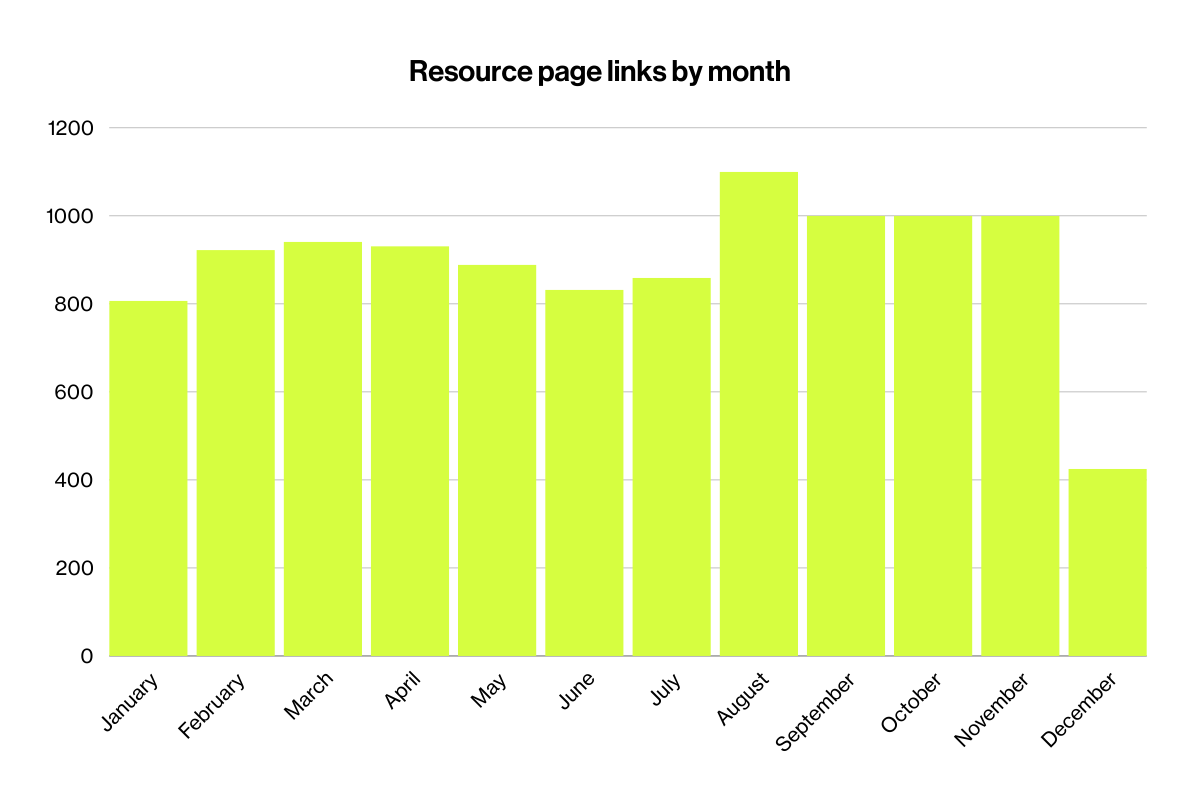
Key insights:
There are some clear seasonal patterns that shape the impact of both editorial and resource page links:
December and January are notably the lowest performing regardless of link type. As discussed in the previous section, the holiday season is typically a time when people will switch off work mode and focus on rest and recuperation, setting themselves up for the next year ahead. Then, once offices begin to reopen, there are often internal strategy and planning sessions that consume people’s time.
The end of Q3 (by calendar year), leading into Q4, is seasonally the most prosperous time across both verticals. There is very little difference between the two graphs during this time period.
April is most negatively impacted in editorial placements, which correlates with the Easter holidays in the UK and US. There’s a notable dip that picks up either side.
Editorial links tend to perform better during the early summer months (June and July) as opposed to resource page links. This is likely because many of these placements are pre-written and planned well in advance. This foresight helps mitigate the impact of slower business activities during the summer. In contrast, resource page links, which typically have a faster turnaround time, are more immediately affected by seasonal trends, making them vulnerable to the slower pace of summer.
Weekly trends (2015-2023)
So, we’ve got a pretty good idea when campaigns are going to be successful, and can plan our strategy and outreach accordingly.
But, can we take what we’ve learned to an even more granular level?
By which, can we predict the days in the week that a webmaster is most likely to link to content? Of course, we can – and with this data, an opportunity to focus your outreach efforts on those key timings.
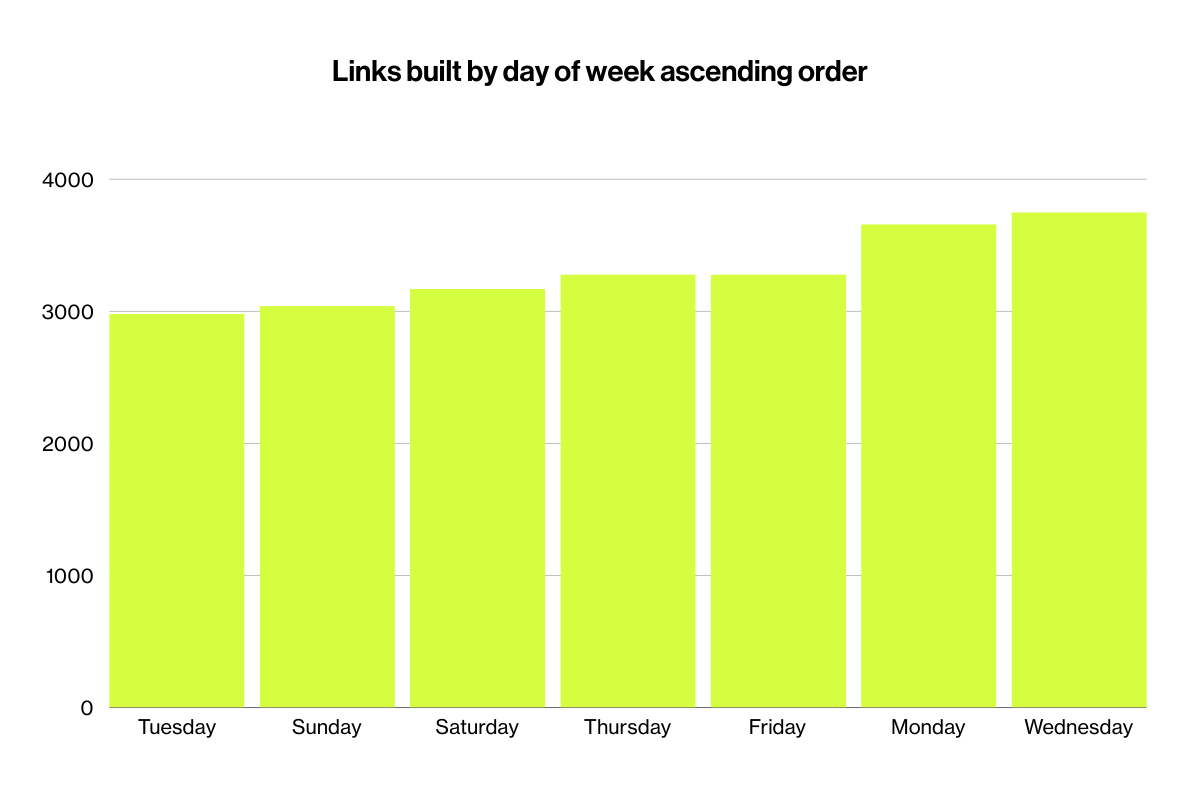
Other insights:
Wednesday and Monday are usually when we see the most number of live links.
Tuesday seems to be the day of the week with the least live links.
October 31, 2022, was our single biggest day for link acquisitions, with 47 links secured in just one day!
We’ve also pulled the numbers to understand WHEN in the month links are most likely to go live, with a week-by-week breakdown below. There isn’t too much to write home about, but it’s interesting data nonetheless and gives us a level of confidence that the backend of months are most likely to see new live links.
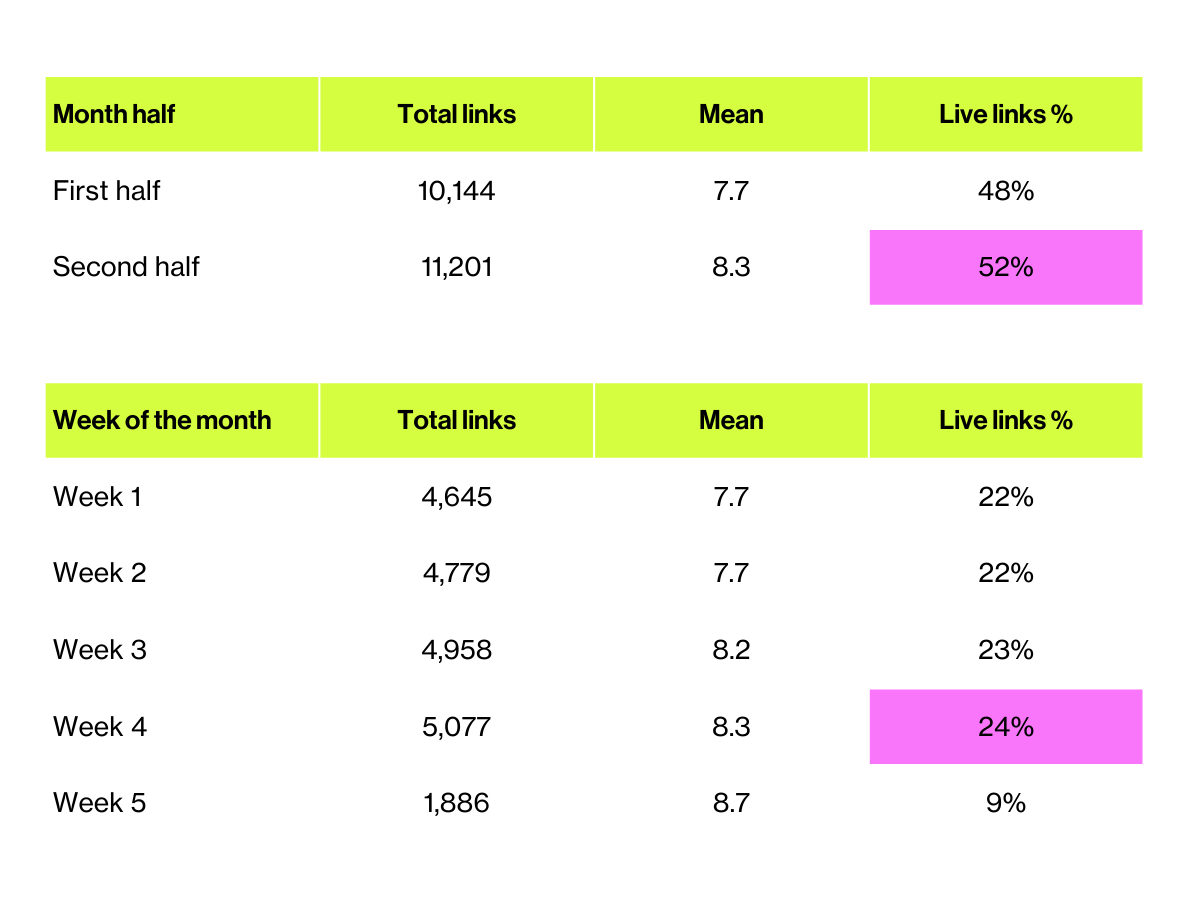
Key insights:
On average, 48% of links go live in the first half of the month, while 52% go live in the second half.
The 3rd and 4th week of the month usually sees the most number of live links, on average.
The 90-day conversion window
When we talk to clients about our link building process, we often use the term snowball effect. Our campaigns are built on momentum – it’s not a flash-in-the-pan digital PR drive that will boom or bust.
We also, for a very large part, don’t focus on seasonal trends or what’s going on in the media.
So, why the snowball effect?
Simply put, much of our link building success can be attributed to the vast audience we reach out to and engage with. Once the link asset is live, we use a number of internal tools and processes to discover thousands of potential sites and content that holds thematic relevance to our client’s work (or the content we’re outreaching).
It’s an ever-evolving campaign – strategised around long-term planning and sustainability.
Here’s a top-level example:
Month 1:
We identify and outreach to 500 websites
50 of these reply
10 say they’ll put a link on their website
5 actually put a link on their website in Month 1
Total links built in Month 1: 5
Month 2:
We identify a further 500 websites and outreach to these
50 of these reply
20 say they’ll put a link on their website
10 actually put a link on their website in Month 2
However, a further five people from Month 1 also put a link on their website
Total links built in Month 2: 15
Month 3:
We identify a further 500 websites and outreach to these
50 of these reply
20 say they’ll put a link on their website
10 actually put a link on their website in Month 3
However, a further 10 people have replied from Month 1 and four of these have now put a link on their website
And, another five people from Month 2 have done the same
Total links built in Month 3: 19
And so on and so forth.
Because webmasters are busy people, we’re continually nurturing and monitoring our pipeline of leads and reengaging with prospects.
This has helped us develop a 90-day link conversion window.
Key highlights:
We’ve observed an interesting trend: On average, 80% of the links acquired in any given month are the result of outreach efforts and activities from the previous 90 days.
This trend has remained consistent across various clients, industries, campaigns, and link models throughout the years.
The 90-day conversion window is so consistent that we’re able to apply a forecasting model based on it, enabling us to reliably predict results and benchmark performance.
Here’s an example of that model, using data from 2023. As you can see, there’s a clear correlation using the 90-day window.
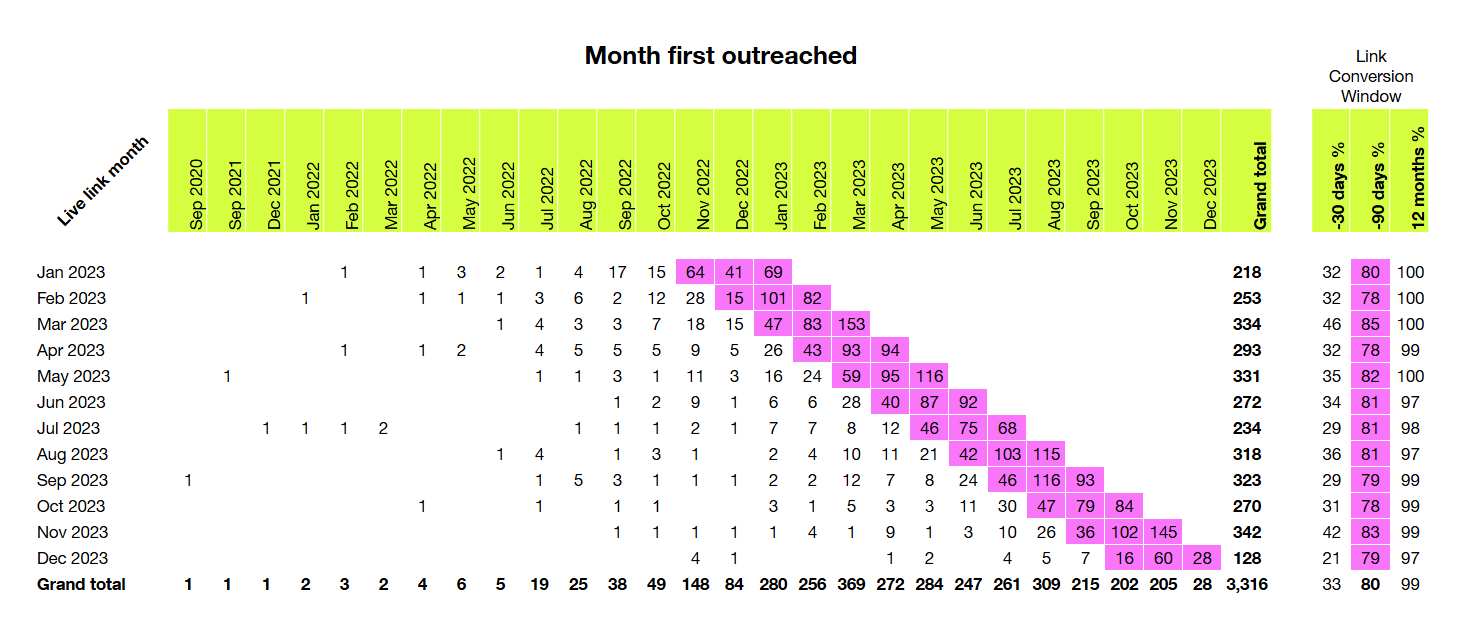
A consistent and structured follow-up strategy is a key pillar of our link-building outreach. It helps us generate more responses, which in turn leads to more link placements over time. We believe the results seen within the 90-day conversion window are a direct reflection of the effectiveness of our follow-up and re-engagement process.
How to capitalise on the data with your own link campaigns
The data speaks for itself. There are clear correlations and trends you can start utilising in your own link strategy – and here are our top tips to help you maximise this effectively:
Plan your content early:
If you’ve read our first blog post, you’ll know the importance of creating exceptional content that will resonate with a wide audience. To do this, and ensure it’s highly linkable, you’ll need data-backed evidence to inform your decisions. The process from start to finish will need many steps and, depending on your organisation, sign-off from a number of stakeholders. You need to think about:
Content that you CAN write about, seeking approval from internal PR teams and content editors.
Developing a range of content ideas, which again, will need approval.
Writing a brilliant piece of content that’s highly linkable. Guess what? You’ll need to get the final piece signed off.
Entering the domain of designers, and going back and forth to ensure it looks just as good as it reads.
Dealing with developers, and the back and forth across many teams to have a final content asset that’s live on your website.
From start to finish, you’re probably looking at anywhere between two and three months – and the last thing you want is to be going live at the end of November (see all the data points above).
Be warned – seasonal content won’t always land:
Digital PR can be hugely successful, tapping into a black book of journalistic contacts and online editors. It gives you an ‘always on’ approach that helps boost brand awareness and can be perfectly timed with key market trigger points in the year. But be prepared and forewarned, if you’re putting all of your eggs in one basket for an explosive summer of link building, you could be left disappointed at the end.
Focus on editorial links in the summer months:
Our data shows summer can be more impactful for editorial links (in content & guest posts). So plan your strategy with this in mind. Focus on and develop resource page links during the spring, and gear up for a summer of editorial content to give yourself a diverse backlink portfolio that’ll deliver organic results.
Don’t kick off a campaign in late autumn:
Again, the data is fairly self-explanatory – but it’s better to wait until the end of January and give yourself a couple of months to build a contact database of thematically relevant leads, rather than launching in mid-late November and hitting a December roadblock. As we mentioned in the first point, have your content primed and ready, with a target list of outreach contacts – setting yourself up for a spring of success.
Develop your link target roadmap around seasonability:
Most companies have an idea of how many links they’re planning to build over a certain period of time. Let’s take 12 months and, for ease, 120 links. Are you going to build an even and steady 10 links per month for the duration of your campaign? Almost certainly not. So instead, design your link roadmap and outreach strategy around our seasonal data. Here’s an example of what that might look like:
January: 2 links. It's the first month of your campaign, and you’re launching at one of the slowest points of the year.
February: 4 links. Things are starting to warm up, but there’s still a hangover from winter.
March: 8 links. Starting to build momentum as we enter spring, with a couple of months of outreach behind us. That 90-day window is coming into effect.
April: 12 links. Full steam ahead moving into Q2, and whilst there may be a noticeable drop off in responses around Easter, the campaign should be building traction.
May: 14 links. This is likely to be your peak month for a while, with summer looming around the corner.
June: 8 links. The decline in responses and live links will now start to hit. Early summer holidays are booked as people rush to avoid the expensive school holidays.
July: 6 links. Focus on editorial placements as these are seasonally better performing at this time of year.
August: 8 links. Towards the end of August, you’ll begin to see traction building again. A few out-of-offices remain, but you’re likely to hit peak link season over the next month or so.
September: 12 links. People are back to work and the summer of discontent is over. Momentum builds and we’re ready to hit the next two months with wind in our sails.
October: 18 links. All of your work to date, and the 90-day window you’ve built will start to pay off now. It’s seasonally the best time of year to acquire new links.
November: 24 links. The campaign’s flying full steam ahead. Take advantage of new outreach, as well as make the most of re-engagements and lead nurturing from earlier in the year.
December: 4 links. Not necessarily a write-off, but it’s worth planning to dial down your outreach efforts over this time. There’s always next year.
What’s next?
By now, you’ve probably realised that link building isn’t simple. You need best-in-class content and a strategy that’ll mitigate any seasonal impact on your goals. Well, what now?
It’s time to start actively building links, identifying the types of sites you want to go after – in the process developing a diverse backlink portfolio that’ll meet and exceed your expectations.
Next time, we’ll cover:
The types of links we build (link products) AND how we build them
How this approach to link building has evolved over time
Our outreach process – What works AND why?
And fundamentally, what doesn’t work?
About the authors
Luke Kyte joined Reddico in 2014 as a content writer. One of Reddico’s first employees, he was responsible for building our content marketing department and establishing processes across the agency – helping Reddico to win its first campaign award back in 2017. In 2024, Luke took on the role of Operations Director and is now responsible for the day-to-day management of the agency – supporting and guiding our approach to SEO and link building operations.
Ron Carandang joined Reddico in 2014. As our Link Building Product Manager, he leads our outreach projects and off-page optimisation campaigns, including content, PR and link building. Having been in the SEO industry since 2008, Ron has a wealth of experience managing the teams involved in delivering successful link building strategies.
If you'd like to discuss how Reddico can help you with link building contact us >
Sign-up to Reddico News
To keep up-to-date with the latest developments in the world of SEO, our insights, industry case studies and company news, sign-up here.




